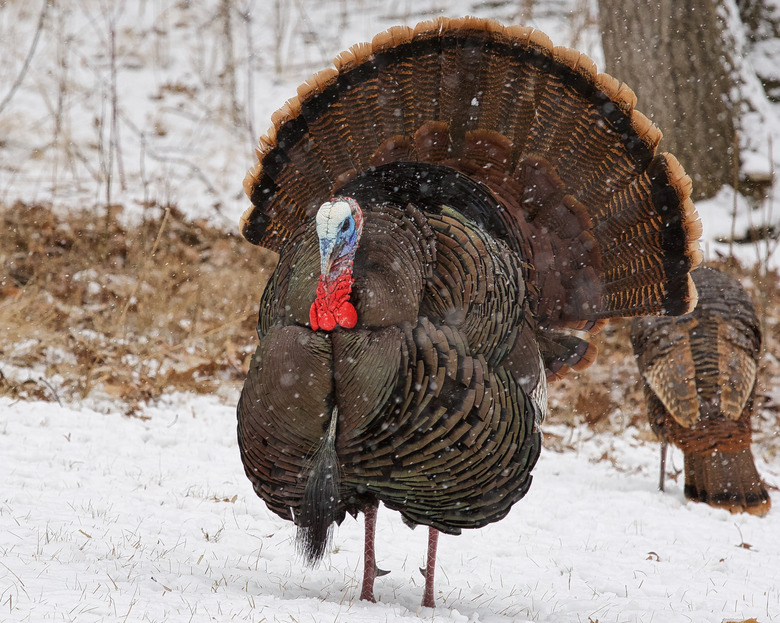How To Tell The Difference Between Male & Female Turkeys
Turkeys (Meleagris gallopavo) represent an iconic North American bird species. The typical domestic variety on farms originated from wild turkeys. Six subspecies of wild turkeys exist, with at least one subspecies in every state of the United States except for Alaska. Mexico boasts the ocellated turkey. Turkey males are called toms or gobblers, and females are called hens. Mature males and females are easily distinguished from each other.
TL;DR (Too Long; Didn't Read)
Turkey are large birds of North American origin. Males, called toms or gobblers, are much larger than females. Males boast dark iridescent plumage; large, fanning tails; prominent snoods; and wattles. They make gobbles and other mating calls. Females, or hens, are smaller, with duller plumage and less prominent features.
Common Features of Turkeys
Common Features of Turkeys
Turkeys belong to the same family as partridges, pheasants and peafowl. They appear large and squat, with 5,000 to 6,000 feathers on their bodies. Turkeys can reach nearly 3 feet tall. They posses a red flap of skin under their chins called a wattle, and they have bumps called caruncles on their heads and throats. A snood dangles from their beaks. Spurs can be found on the backs of their lower legs. The omnivorous wild turkeys eat roots, tubers, acorns, nuts, berries, flowers, amphibians, insects and even reptiles. Turkeys possess excellent sight but poor senses of smell and taste. Wild turkeys, unlike their domesticated cousins, fly well, from 40 to 55 miles per hour. They also swim and can run as fast as 25 miles per hour. Turkeys roost safely in trees or dense vegetation at night, preferring woodlands, grasslands, savannas and even swamps. They roam according to weather conditions and gather in large flocks in winter. A pecking order or hierarchy exists among flocks.
Turkey Hens
Turkey Hens
Wild female turkeys, or hens, weigh from 5 to 12 pounds and range from 30 to 37 inches long. Hens bear less colorful feathers than males, with rusty brown, white or gray-tipped breast feathers. Their heads are either white or blue-gray, with small feathers on both head and neck. Their wattles, snoods, caruncles and spurs are small. Hens make vocalizations such as yelps, clucks and cuts. Approximately 10 percent of hens possess a "beard," or elongated chest feathers. Hens do not strut or fan their tails. Females can lay from nine to 13 eggs, which they incubate for around 28 days. Well-nourished females in good physical condition nest earlier than females in poor condition. The feces of females can be distinguished from males as it is shaped like the letter "J."
Male Turkeys: Toms or Gobblers
Male Turkeys: Toms or Gobblers
Male turkeys are called toms or gobblers. They weigh from 18 to as much as 25 pounds and are almost 3 feet tall, making them significantly larger than females. Adult toms boast featherless red, blue or white skin on their heads; the color changes as males grow excited. Toms possess a long "beard" on their chests, with long, hair-like feathers that stick out. Males have very dark bodies, but upon close inspection numerous iridescent colors such as bronze, gold, copper, green, blue and red can be found. Their spurs are much larger than on females, ranging up to 1.5 inches long. These are used for fighting other toms and predators. The toms' prominent snoods expand or contract at will and hang over their beaks. Toms are polygamous. They can be dominant or subordinate depending on their gene expression. Dominant males possess exaggerated masculine traits at sexual maturity. Subordinate males can assist their dominant brothers in mating, but only dominant males will sire poults (babies). Toms strut and fan out their tail feathers as part of their display. As their alternate name suggests, males make gobble sounds, along with approximately 30 other calls. Males' feces can be distinguished from females' due to its spiral shape.
Breeding Habits of Turkeys
Breeding Habits of Turkeys
In spring, mature turkey hens determine the timing of breeding. Toms begin their cacophonous gobbling sounds, alerting other males and females. In addition to gobbling, toms make elaborate displays to attract females. They strut, drag their wings and long tail feathers in the dirt, puff out their "beards" and most spectacularly, fan their tail feathers in a great arc. Hens prefer toms with long snoods, as those indicate good health. Toms are polygamous and will mate with several different hens over the course of breeding season. Related males assist in courtship, but only the dominant male will actually mate.
Upon mating, a hen will leave to nest by herself. Hens prefer brood habitats with some cover, but with good visibility to keep watch for predators. The hen forms a loose nest and lays up to 13 cream-colored eggs. In between laying, hens forage for food and roost. Nesting hens prove vulnerable to predators. The eggs themselves face risk of predation before hatching. After 28 days of incubation, the eggs hatch. The mother hen relocates her babies, called poults, to areas with plentiful insects for them to eat. From two to three weeks old these young poults can fly and roost. Many will not reach maturity due to weather or predation from such animals as weasels, coyotes, mink, raccoons, skunks and snakes. A hen attempts to distract potential predators by feigning injury and leading predators away from her young, who await her signal in hiding for safety. Despite predation and mortality risks, wild turkeys continue to thrive, with approximately 7 million currently residing in the United States.
References
Cite This Article
MLA
Hermance, Dianne. "How To Tell The Difference Between Male & Female Turkeys" sciencing.com, https://www.sciencing.com/tell-between-male-female-turkeys-5810985/. 23 April 2018.
APA
Hermance, Dianne. (2018, April 23). How To Tell The Difference Between Male & Female Turkeys. sciencing.com. Retrieved from https://www.sciencing.com/tell-between-male-female-turkeys-5810985/
Chicago
Hermance, Dianne. How To Tell The Difference Between Male & Female Turkeys last modified August 30, 2022. https://www.sciencing.com/tell-between-male-female-turkeys-5810985/
